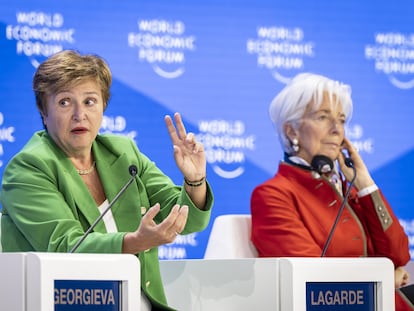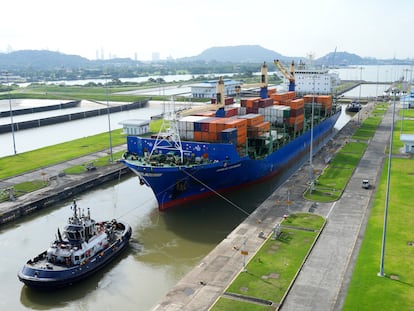Plan Mexico: Sheinbaum’s strategy to attract investment amid uncertainty over Trump
The six-year roadmap, which seeks to curb the arrival of Asian imports and increase national production, must first overcome tariff threats from the U.S. and the upcoming review of the USMCA

Mexico is aiming for a complete turnaround in its industrial policy through the “Plan Mexico” initiative. President Claudia Sheinbaum unveiled her ambitious six-year strategy this month, which is aimed at targeting $277 billion in investments, reducing imports from Asia — particularly China — and boosting domestic and North American production. While Sheinbaum insists that the plan is not a direct response to U.S. President Donald Trump’s recent threats of imposing a 25% tariff on Mexican imports, the government’s blueprint arrives in a challenging context due to the uncertainty generated by Trump’s rhetoric, a slowdown in local consumption, and an overall economic deceleration in the country.
The six-year goals of Plan Mexico are ambitious: to position Mexico among the top 10 economies globally, create 1.5 million jobs in specialized manufacturing, increase national content by 15% in strategic sectors (automotive, aerospace, electronics, semiconductors, pharmaceuticals, chemicals), train 150,000 professionals and technicians annually, and improve access to financing for small and medium-sized enterprises (SMEs). The strategy kicked off last week with a fund of up to 30 billion pesos in tax incentives for companies investing in innovation and training. Through a decree, Sheinbaum formally launched her flagship plan, defending the subsidies as a means to strengthen local businesses and simplify support for foreign companies relocating to the country. The decree will remain in effect until September 2030, with the largest subsidies allocated to technology companies and a portion set aside for SMEs.
The plan — Sheinbaum’s cornerstone economic initiative — was presented at the World Economic Forum in Davos, Switzerland. Federal officials held meetings with international companies to promote the plan’s investment and employment goals. However, the finer details of the strategy remain unclear given the macroeconomic environment, which is marked by uncertainty, slowing investment, and limited national economic growth. Financial experts and multilateral organizations agree that Mexico’s GDP is projected to grow by less than 2% this year.
Alfredo Coutiño, director for Latin America at Moody’s Analytics, warns that in order for Plan Mexico to achieve its objectives, the Mexican economy must grow at a steady rate of over 5% annually for the next six years. This goal seems challenging, given that the Treasury’s forecast for this year is only 3%. Coutiño also notes that the target of creating 1.5 million jobs annually is overly optimistic, as the country has averaged around 800,000 jobs per year over the last three years. “Plan Mexico faces an environment of uncertainty and internal risks, stemming from constitutional reforms that have already raised concerns among investors. On top of this, we must add the protectionist policy of the new U.S. president, which also adds uncertainty to foreign investment decisions,” he says.
Coutiño acknowledges that the emphasis in Sheinbaum’s economic roadmap on addressing the trade imbalance with China and the proposal for industrial reconversion to replace imports, particularly from China, with domestic production aligns with Trump’s call to halt the Asian giant’s advance in North America.
He points out that the new protectionist stance of the United States against Mexico presents a significant risk that could derail Plan Mexico’s objectives for Sheinbaum’s entire six-year term. “Even with the ratification of the USMCA, Trump’s protectionist policy, at least in 2025, will be a headache for the Mexican economy, because it will introduce disruptions in bilateral trade with potential restrictions on imported inputs for the national industry,” says Coutiño. “This could lead to lower growth for Mexico’s economy, or even a recession in 2025.”
Viri Ríos, a researcher and expert in public policy, notes that Plan Mexico’s priority is to shift the country from being an exporter of assembled goods to an exporter of high-value-added products. She stresses that for the strategy to succeed, it must not only support businesses but also filter out companies that fail to meet the commitments on import substitution and innovation, for which they received government assistance. Ríos goes further, suggesting that the plan should include training for entrepreneurs and offer incentives to traditional businesses willing to shift their focus to higher-value sectors.
Rodrigo Aliphat, director of the Development Studies Division at Mexico’s Center for Economic Research and Teaching (CIDE), explains that in Mexico’s push to integrate commercially with North America and boost exports under the USMCA, it inadvertently opened the door to increased imports, which undermined Mexican industries. “The trade agreement with the U.S. and Canada allowed Mexico to increase its exports, but the flip side was that as exports rose, so did imports, which led to the replacement of domestic production chains with imported goods from other countries,” he argues.
The trade agreement signed in the 1990s between Mexico, the United States, and Canada and ratified in 2020 is now under scrutiny from Trump. During his campaign, the Republican made it clear that he would not hesitate to request a renegotiation of the USMCA if it served his country’s interests. Just hours after taking office, the American president requested that his government analyze the benefits the treaty has brought to the United States. While the next official review of the agreement is scheduled for June, U.S. newspapers are speculating that this evaluation could take place earlier due to pressure from Trump.
Aliphat, an expert in industrial policy, explains that due to Mexico’s commercial dependence on the U.S. market — where 80% of exports are sent — its northern neighbor must remain an integral part of its strategy. However, he suggests that the Mexican government should also diversify its export destinations to reduce dependency, pointing to Europe, South America, and Asia as potential markets. He stresses that Mexico needs to start developing these markets to avoid being overly reliant on the U.S. and its political fluctuations. Aliphat further notes that the real success of Plan Mexico will be seen when Mexico transitions from merely assembling products with foreign components to producing goods made by Mexican companies, in addition to the strengthening of local business conglomerates.
In 1994, the year the North American Free Trade Agreement (NAFTA), now the USMCA, was signed, Mexico’s then-secretary of commerce and industrial development, Jaime Serra Puche, famously said: “The best industrial policy is the one that does not exist.” Today, specialists agree that 30 years later, the Sheinbaum government, with Plan Mexico, is setting a new course for economic and industrial development with a focus on strengthening Mexican businesses. The road ahead, they caution, will not be easy or short, but the first step has been taken.
Sign up for our weekly newsletter to get more English-language news coverage from EL PAÍS USA Edition
Tu suscripción se está usando en otro dispositivo
¿Quieres añadir otro usuario a tu suscripción?
Si continúas leyendo en este dispositivo, no se podrá leer en el otro.
FlechaTu suscripción se está usando en otro dispositivo y solo puedes acceder a EL PAÍS desde un dispositivo a la vez.
Si quieres compartir tu cuenta, cambia tu suscripción a la modalidad Premium, así podrás añadir otro usuario. Cada uno accederá con su propia cuenta de email, lo que os permitirá personalizar vuestra experiencia en EL PAÍS.
¿Tienes una suscripción de empresa? Accede aquí para contratar más cuentas.
En el caso de no saber quién está usando tu cuenta, te recomendamos cambiar tu contraseña aquí.
Si decides continuar compartiendo tu cuenta, este mensaje se mostrará en tu dispositivo y en el de la otra persona que está usando tu cuenta de forma indefinida, afectando a tu experiencia de lectura. Puedes consultar aquí los términos y condiciones de la suscripción digital.
More information
Archived In
Últimas noticias
The relentless struggle between factions deepens the Sinaloa war: bodies in coolers and a surge in homicides
‘Doctor Death’, the journalist who has witnessed 105 executions in Florida
Being trans or gay in a migrant detention center: ‘They call me faggot, queer, bitch’
The metaverse, four years later: Is it finished or just at a standstill?
Most viewed
- The low-cost creative revolution: How technology is making art accessible to everyone
- Christian Louboutin: ‘Young people don’t want to be like their parents. And if their parents wear sneakers, they’re going to look for something else’
- All the effects of gentrification in one corner of Mexico’s Colonia Roma
- Liset Menéndez de la Prida, neuroscientist: ‘It’s not normal to constantly seek pleasure; it’s important to be bored, to be calm’
- Christmas loses its festive spirit: ICE fears cast shadow over religious celebrations











































